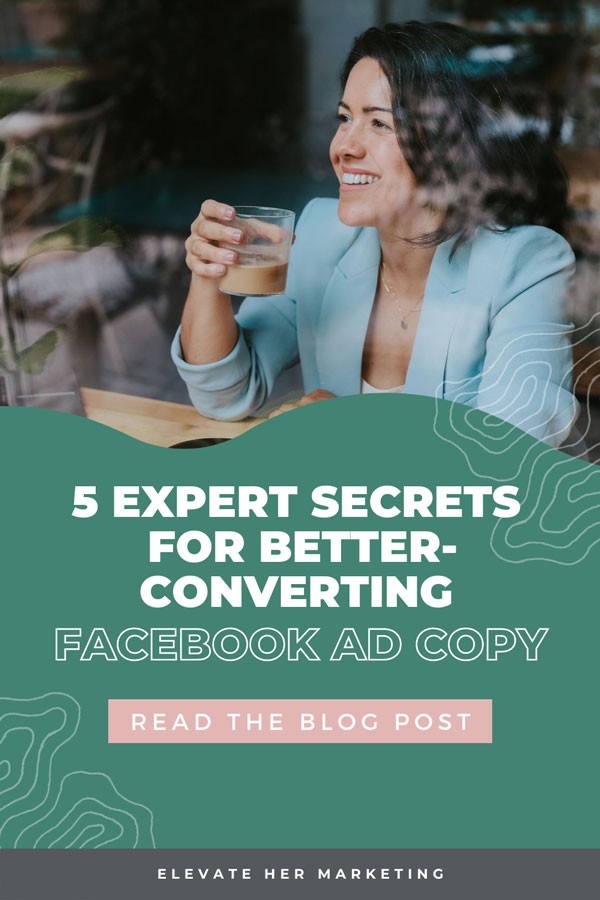
5 Expert Secrets for Better-Converting Facebook Ad Copy
In this post, we’ll share five secrets behind writing compelling Facebook ad copy.
Secret #1: Use an Opening Question to Get Readers Saying “Yes”
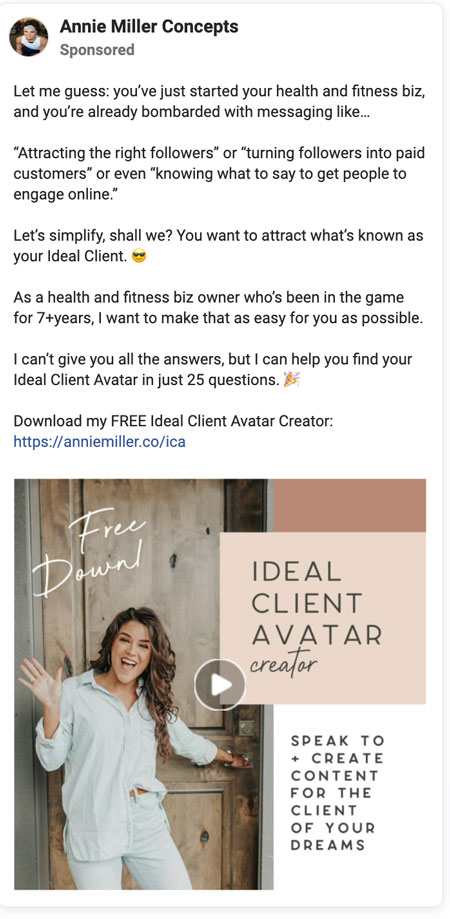
“Yes” questions should be at the top of your ad to draw your audience in. That first line is key! If they read that, the chances that they will read the rest of the ad increase drastically.
This ad is targeting personal trainers who have just started a health and fitness business. The advertiser – Annie Miller – is sympathizing with them about getting bombarded with marketing messages and trying to sort out what to do with them. Her target audience will likely feel a sense of relief that someone out there understands them. Right out of the gate, her ad has them saying “Yes, that’s me!”
What’s next? The solution, of course. “Let’s simplify this and attract your ideal client.” And who is going to help them do that? Annie, because she has the knowledge and the authority: “As a health and fitness biz owner who has been in the game for 7+ years, I want to make that as easy for you as possible.”
Secret #2: Tell Them the Benefits Before the Features
A common mistake in facebook ad copywriting is writing first about the features of a product or service rather than the benefits. While the features may be appealing, they don’t explain why someone should buy a product or subscribe to a service.
An important thing to know about marketing and copywriting is that people are naturally always thinking about themselves, so they want to know right away what the benefit is to them if they pay attention to what you’re saying.
Ultimately, the benefit they will receive is always the real reason behind their buying decision. How will something improve their lives, jobs, status, or relationships? What value will they realize?
For example, when someone is buying a car, they want to know how it will change things for the better. They want to know how they will spend less on gas, how it will save them time, or how it will make their commute more pleasant.
They could be buying a car because it has 7 cup holders or an extra-long moon-roof, but it’s more likely that they’re buying a car because it’s going to improve their life in some way.
The features are what the person is buying. The benefits are why they’re buying it.
One way to ensure that you’re leading with the benefits is to consider each feature one at a time and use the connecting word “so” plus what it will help the customer accomplish. For example:
- Join our Facebook group for free so you can get insider tips and have your questions answered by experts
- Download this free ebook so you can start experiencing the joy of leaving work on time and seeing your friends and family more
Using “so” ensures that you’re advertising benefits.
People do want to know about the features, but they act on the benefits, so features can come later in the buying process — they also don’t need to be as prominent in your marketing as benefits.
Download the Plan Before You Pay Cheatsheet
Everything you need to have ready before investing in Facebook & Instagram Ads
Secret #3: Play the “We Have Things in Common” Card
It’s important to make your ads relevant to your audience. When you run Facebook ads, you’re competing against thousands of other advertisers. Something needs to differentiate you from your competitors in your customer’s mind in order for them to engage with your ads.
Most people will scroll past ads unless they see something they identify with right away. Especially if you’re reaching out to a cold audience, there has to be something relevant for them to latch on to. One of the ways this can be done is to talk about things that you have in common. Some examples:
- Share a story about what led to the creation of the product or service
- Ask a form of “are you like me” question and describe a common challenge or frustration
- Use a quote or compelling line that you know your audience thinks about often
Think about anything you might have in common with your prospects and talk about these things. This will establish familiarity and trust, which are important factors in buying decisions.
Secret #4: Include Data (Numbers) in the Ad Copy
Numbers have a way of getting people’s attention. People are scrolling and skimming, so seeing a number may just entice them to slow down and see what your ad is about.
You might not remember but we used a number in the headline of this blog post! We could have simply said “Expert Secrets for Better-Converting Facebook Ad Copy” but a headline with a number will always do better than the same line without one!
If you want to showcase how you’ve helped other clients, saying “we helped one client generate $1,017,578 in sales” (by the way, we did) is more compelling than “we help clients get more sales.” Don’t round the data to more generic, even numbers. Specific numbers tend to draw and keep attention.
Using numbers in your ad copy is a great way to attract readers’ eyes and increase your clicks.
Secret #5: Use ONE Clear Call to Action
Your CTA is the call to action, or the action that you want a person to take. Rather than using something generic like “click here” or “like us,” clearly state what you want people to do, using strong action words. Here are some examples:
- Download your free ebook
- Sign up now
- Take 50% off today
- Reserve your seat
Whatever your CTA is, make sure that it is specific and that there is only one possible action for the visitor to take. Providing more than one CTA (for example, “like our page” and “order now”) can make it unclear what you really want people to do, whereas a single CTA like “reserve your seat” gives them only two choices – do it, or don’t do it. And if we already have them saying “yes” in their minds (see secret #1), we’ve increased the odds that they will.
Another thing to keep in mind is that Facebook offers a standard collection of CTA buttons, so your job is literally to write compelling enough copy to get users to click on the Facebook CTA button you’ve chosen for your ad. It often helps to have a CTA in the ad copy as well – see the first ad (Christina Galbato blogging course) in our Facebook ad examples below.
Bonus Secret #6: Understand the Customer Journey and Find Them at the Right Time
Buying Journey
- Browsers: Since Facebook ads use a model called interruption marketing (rather than intent marketing), people who aren’t ready to buy will typically search Google because they’re not sure what they want, they’re just giving it some thought. Unless your goal is specifically brand awareness, browsers are less likely to convert and it’s best to target the audiences of shoppers and buyers.
- Shoppers: Shoppers have a good idea of what they want, they’re just looking for the best quality, the best service, the best deals – and they may be interested in your offer if you hook them with the right opening question (secret #1) and show them the right benefits (secret # ).
- Buyers: Buyers know exactly what they want, and want to know the best business from which to purchase it. Intent marketing – such as Google ads – is great for drawing buyers because they often search for a specific product (like “price of iphone 14 in blue). But Facebook ads are also great for capturing buyers. Most people check their social media accounts several times a day, and if your custom audience includes rabid enthusiasts of whatever the product or service is, you can easily catch people when they are ready to buy.
Relationship to You and Your Brand
- Cold audience: Cold traffic means people who have never heard of you before. They’re unlikely to stop scrolling just because they see your brand – they’re not familiar with you at all.
- Warm audience: These people have heard of you before, whether it’s via word of mouth, seeing your brand in search results, or seeing your ads often enough that they’ve become familiar – but they haven’t made a purchase yet.
- Hot audience: Another way of saying “hot audience” is “customers!” They have made a purchase from your business in the past and have been satisfied or delighted with the experience.
The messaging you deliver to these audiences should match your relationship with them and where they are in the buying journey. If your ad is a new product you want to offer to current or former customers, you can use a more casual and familiar tone. If you’re reaching out to buyers in a cold audience, your ad copy should be more persuasive about the benefits and show more social proof.
How to Write Facebook Ad Copy: Examples
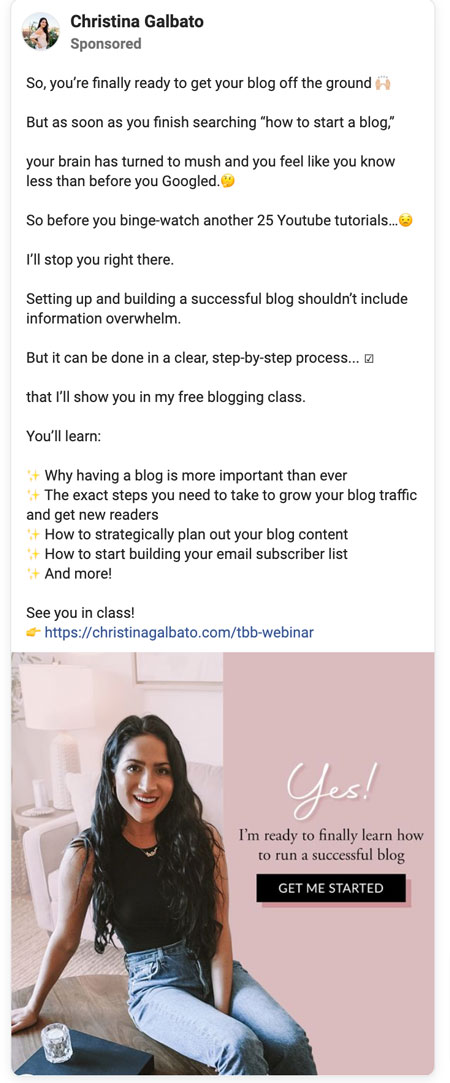
- The first statement gets the target audience – people starting blogs – saying YES.
- The advertiser – Christina Galbato – feels their pain but says hey, I got you with my class that gives you a clear step-by-step plan.
- There’s a CTA link (See you in class!) in the ad copy as well as a CTA button (Get Me Started) in the image.
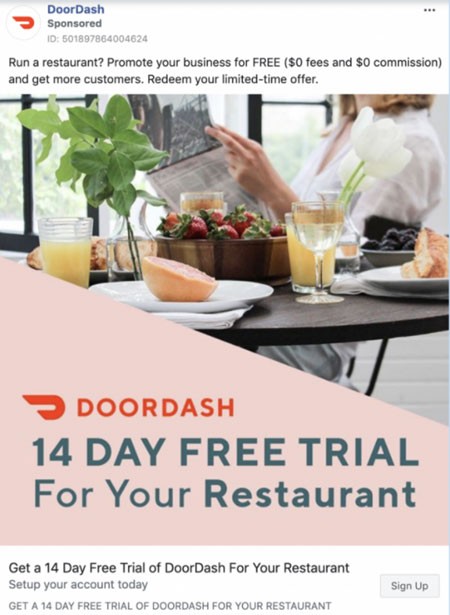
- Asks a question that gets the right audience answering “yes.”
- The benefit is obvious: promote your restaurant for free for 14 days and get customers just for trying it out.
- There’s a single CTA: Sign up.
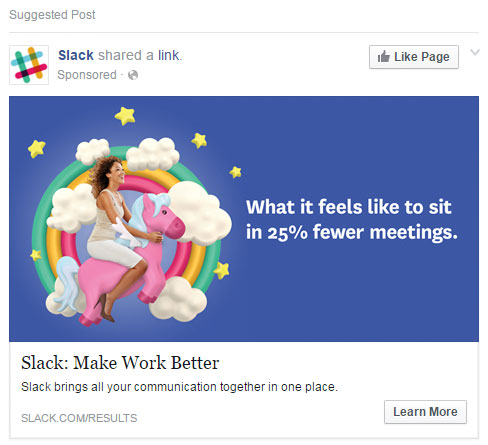
- Showcases a pain point and solves it in the same single line: What it feels like to sit in 25% fewer meetings.
- The slogan is short and compelling: Make Work Better. Who doesn’t want that?
- One thing we don’t love about this: There are two CTA buttons (Like Page and Learn More). But we’ll cut them some…slack. Tip your server, try the prime rib, we’re here all week.

- Poses a “what if” question that AirBnB hosts definitely ask themselves
- It’s obvious that the advertiser understands short-term rental host challenges
- Promotes the idea that the host is one lost in a sea of many, but it doesn’t have to be that way because they can be part of the few on the inside who know how to work profitably
- They will show the hosts how to do this in a free workshop, and they draw more interest by including a short video
- What they’re “selling” is free, so it will convert – and then they will have live prospects in the webinar, which means upsell opportunities
Conclusion
While this post includes some great tips on how to write facebook ad copy, it’s still only a starting point. High-converting Facebook ads require continuous monitoring, testing, and tweaking.
You can learn even more about creating the right ad copy for your own audience by booking a Strategy Party, or let us do the hard work for you with our All the Things service.
Download the Plan Before You Pay Cheatsheet
Everything you need to have ready before investing in Facebook & Instagram Ads
Pin it for later!
